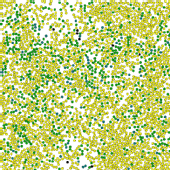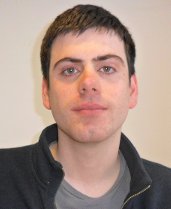Dr David Bray
Dr David Bray is a PDRA working on on Biochemistry modelling in the Department of Chemistry with Dr Rebecca Notman and Dr Tiff Walsh (2011- Present) . He is a member of the Centre for Scientific Computing here at Warwick.
- He previously held a joint-postdoc position between Mechanical Engineering at Imperial College London (March 2010- August 2011) and Mathematical Sciences at Queen Mary University of London (March 2010- March 2011) working with Dr Ambrose Taylor (Imperial), Professor Steven Gilmour (Statistical Sciences, University of Southampton) and Professor Felicity Guild (Imperial).
- He studied for a PhD in Physics at University of Nottingham (2005-2010) under the supervision of Dr Mike Swift and also has a MSci in Mathematical Physics from the same institution (2001-2005).
My interests are computational modelling and characterisation of complex structure. Complex structure can arise in range of materials and has lead me to be involved in modelling granular media, nanoparticle composites and lately proteins. This involves the application of computational and statistical techniques such as molecular dynamics, Monte-Carlo simulation, statistical mechanics and spatial statistics.
Keratin filaments
I am currently working on Modelling the elastic and barrier properties of skin: an investigation of Keratin self-organisation at the molecular level.
This project represents a 2.5 year research collaboration between the University of Warwick and Unilever. We intend to gain insight into the mechanical properties of Keratin intermediate filaments at both a molecular-level and macroscopic scale. Keratin filaments are a key structural component found within skin cells which effects skin's elasticity and toughness. By enhancing our understanding of its behaviour we will be able to better understand its performance under various moisture environments.
Measuring particle dispersion within nanocomposites
Nanocomposites are materials where nanoparticles are embedded into a polymer matrix (such as a epoxy resin) to enhance the mechanical properties of the material. The concentration, material and shape of the nanoparticles can all influence the properties exhibited by the material. However, the spatial arrangement and overall coverage of nanoparticles within the composite also play a role. Poor coverage and dispersion of the nanopartcles leads to clustering which could result in undesired properties. Hence to be able to objectively quantify the degree of nanoparticle dispersion within a material would allow the degree of correlation between particle dispersion and desirable material propertiess to be investigated and thus lead to improved composite materials. However there are no existing standards for the measurement of spatial dispersion.
This project was a collaboration between engineering and statistical sciences to design a robust measure for quantifying nanoparticle dispersion. A key aim of the project was to develop an intuitive statistical measure that could be applied objectively to real samples of a material. Experimental mmeasurement of a material is restricted to a few sample micrographs of the material's microstructure due to their expense and the destuctive nature of sample preparation. Hence we needed to gauge the pperformance of the measure and its interpretation under the likely conditions expected in real experiments. This poses important questions on how the data quality gathered from experiment effect our interpretation of these measures.
In order to use these measures in practice with confidence we need to know how the value of the nanoparticle dispersion parameter corresponds qualitatively to the degree of dispersion. We have investigated the behaviour of nanoparticles with various morphologies.
The shape of the nanoparticle and overall area fraction (density) in the micrograph are both found influence the measurement. Both these arise because of geometrical constraints on the particle arrangement induced by the nanoparticles. Thus a careful interpretation of the nanoparticle dispersion parameter is needed to avoid misinterpretation.
Statistical properties of a steady-state granular gas
2005-2010
Granular particles are macroscopic grains which only interact and dissipate energy upon collision. As such they cannot reach an equilibrium state unless all the particles are at rest. Granular particles in motion can settle into a steady state when the rate of energy injected into the system equals that which is lost though collision. Although highy energetic beds of grains are often though to be in a 'gaseous' like state, and thus treatable by mean field theories, highly energetic granular particles can behave anomously. Thus the statistical properties of these systems can deviate from that expected for brownian motion producing fat tail statistics. This PhD project studied the structural and dynamical behaviour of one and two-dimesional 'gas' of granular particles found at the steady state, and found both spatial and kinetic deviations from that expected using mean field theory.

Fig. 2D Granular gas of grains: yellow particles are slow moving and black have high kinetic energy.
The velocity of a particle is highly correlated to the space available for the particle to move. It also violates the spatial homogeneity.
Publications
-
D.J. Bray, P. Dittanet, F.J. Guild, A.J. Kinloch, K. Masania, R.A. Pearson, A.C. Taylor, Polymer (2013), The modelling of the toughening of epoxy polymers via silica nanoparticles: the effects of volume fraction and particle size DOI:10.1016/j.polymer.2013.10.034
- D.J. Bray, A.C. Taylor, Quantifying the Dispersion of Nanoparticles in Polymers, in Handbook of Nanomaterials Vol 2: Characterisation and Reliability (2013 in press)
- D. J. Bray, S.G.Gilmour, F. J. Guild, A. C. Taylor, Composites: Part A (2013), The effects of particle morphology on the analysis of discrete particle dispersion using Delaunay Tessellation, 54, 37-45 (abstract)
 DOI:10.1016/j.compositesa.2013.07.003
DOI:10.1016/j.compositesa.2013.07.003 - A.C. Taylor, D.J. Bray, S.G. Gilmour, F.J. Guild, and K. Masania, Quantifying the Dispersion of Nanoparticles in Adhesives, in 2013 Annual Meeting of the Adhesion Society, G. Schueneman, Editor (2013), The Adhesion Society: Daytona Beach (This won the best poster award)
- D. J. Bray, S.G.Gilmour, F. J. Guild, A. C. Taylor, Journal of the Royal Statistical Society Series C (2012), Quantifying nanoparticle dispersion by using the area disorder of Delaunay triangulation, 61, 253-275(abstract) (listed)
- D. J. Bray, S.G.Gilmour, F. J. Guild, T. H. Hsieh, K. Masania, A. C. Taylor, Journal of Materials Science (2011), Quantifying nanoparticle dispersion: application of the Delaunay network for objective analysis of sample micrographs, 46, 6437-6452 (abstract) DOI: 10.1007/s10853-011-5615-4
- D. J. Bray, M. R.Swift, P. J. King, Physical Review E (2007), Velocity statistics in dissipative, dense granular media, 75, 062301 (abstract)
- D.J.Bray (2010) Statistical properties of a randomly excited granular fluid. PhD thesis, University of Nottingham (abstract).
Conference Attendance
- 6-7 February 2014, The Royal Society: Frontiers of computer simulation in chemistry and materials science, Chicheley Hall, Buckinghamshire, UK.
- 7-9 January 2014, CCPBioSim/CCP5: Multiscale Modelling Conference, Manchester, UK.
- 1-6 December 2013, 2013 MRS fall meeting & exhibit, Boston, US.
- 3-5 April 2013, CPP5/MDNet: quantification of quality in atomistic and molecular simulations, University of Warwick, Coventy, UK
- 26-27 November 2012, Conference on Biomolecular Thermodynamics, Institute of Physics of Physics, London, UK
- 3-7 September 2012, CMD-24 (ECOSS-29, CMMP-12, ECSCD-11), EICC, Edinburgh, UK
-
27 June 2012, CCPBioSim Conference “Frontiers of Biomolecular Simulation”, Royal Agricultural College, Cirencester, UK
- 24-27 June 2012, Computational Molecular Science 2012, Royal Agricultural College, Cirencester, UK
- February 2011, QMUL statistics seminar series, Mathematical Science, Queen Mary University of London
- December 2010, ERCIM10, Senate House, London, U.K.
- April 2009, Inaugural Meeting of the Nonlinear and Complex Physics Group (IOP), Manchester University, U.K.
- March 2009, Colloids, Grains and Dense Suspensions: under Flow and under Arrest, Discussion Meeting, The Royal Society (London), U.K.
- February 2008 Workshop on Pattern Formation in Particle systems, Warwick, U.K.
- June 2007, Satellite conference of StatPhys 23, Napoli, Italy
- July 2006, Dygram2006 - Granular Dynamics, Jamming, Rheology and Instabilities conference, University of Rennes, France
Contact Details
Dr David Bray,

Department of Chemsity,
University of Warwick,
CV4 7AL
Email: D dot Bray at warwick dot ac dot uk
